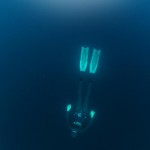Just a few words about what was perhaps the greatest dive in history . Alexey Molchanov declared 128 CWT –what happened is another story ,in fact he descended to 129.7 mts ,Effectively 130 mts , he could’nt find the tag – Why ? there are several reasons – narcosis is part of the story . One gets very stoned at this depth .Alexey however breathes up on the surface in a vertical position and is a moderate packer,so probably at the end of packing he does not have much more air in his lungs than if he had breathed up on his back and taken one giant breath before diving.
Now here is where the dive became something beyond the extraordinary , he spent 14 agonising seconds looking for the tag at 130mts ,that is a very long time there. He could’nt locate the tag because it was above him ,he had passed the plate !! On his 126 mt world record he also passed the plate ,was narcosis the only explanation ? I don’t believe so , There are several other factors
1 the plate does not seem to have been illuminated .
2 For some inexplicable reason the tags were black and also not luminous , this is what one sees in the photos
if this is indeed the case ,somebody was seriously stupid.
In spite of all this Alkexey returned to the surface and completed a clean protocol .
What can this man do ? he has elevated freediving and the human potential to the level of the super human ! This dive ,a very short time ago would have been achievable by only 2 or 3 people in the world in No Limits !! And none of them could have spent 14 seconds on the bottom !!
 The Sanskrit Sutra quote, and incidentally, the name I gave to my small freedivers boat , “Ishvara Pranidhana” , can be absurdly simplified to, “I surrender all that I am to YOU”, whether that be that your god, the universe, or the elements you perceive to hold that immensity. I feel the sea, the water, the air….
The Sanskrit Sutra quote, and incidentally, the name I gave to my small freedivers boat , “Ishvara Pranidhana” , can be absurdly simplified to, “I surrender all that I am to YOU”, whether that be that your god, the universe, or the elements you perceive to hold that immensity. I feel the sea, the water, the air….